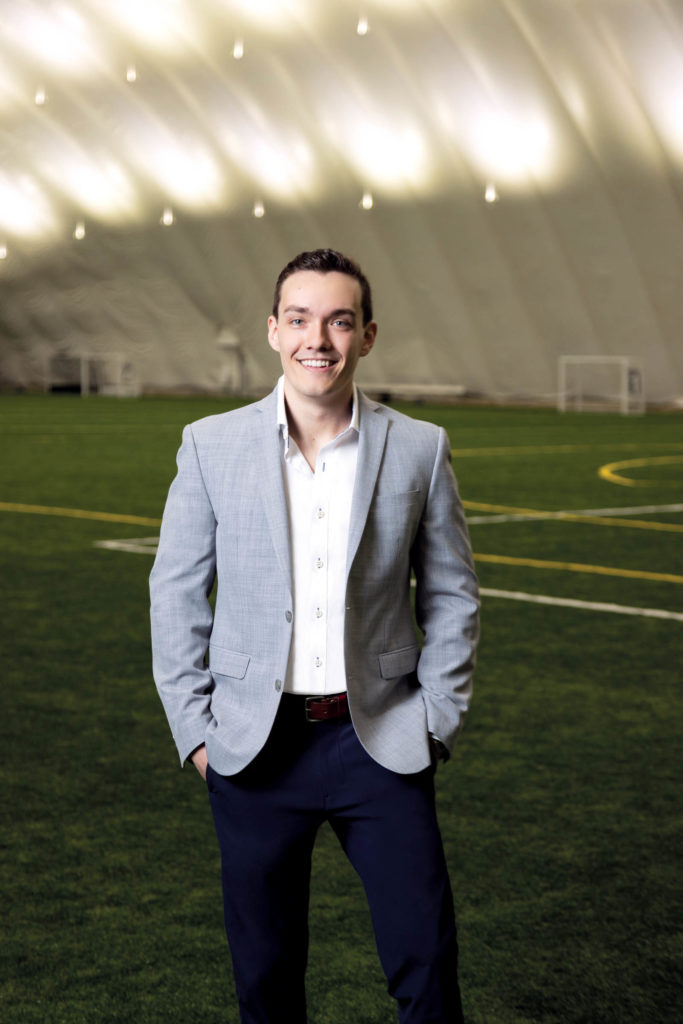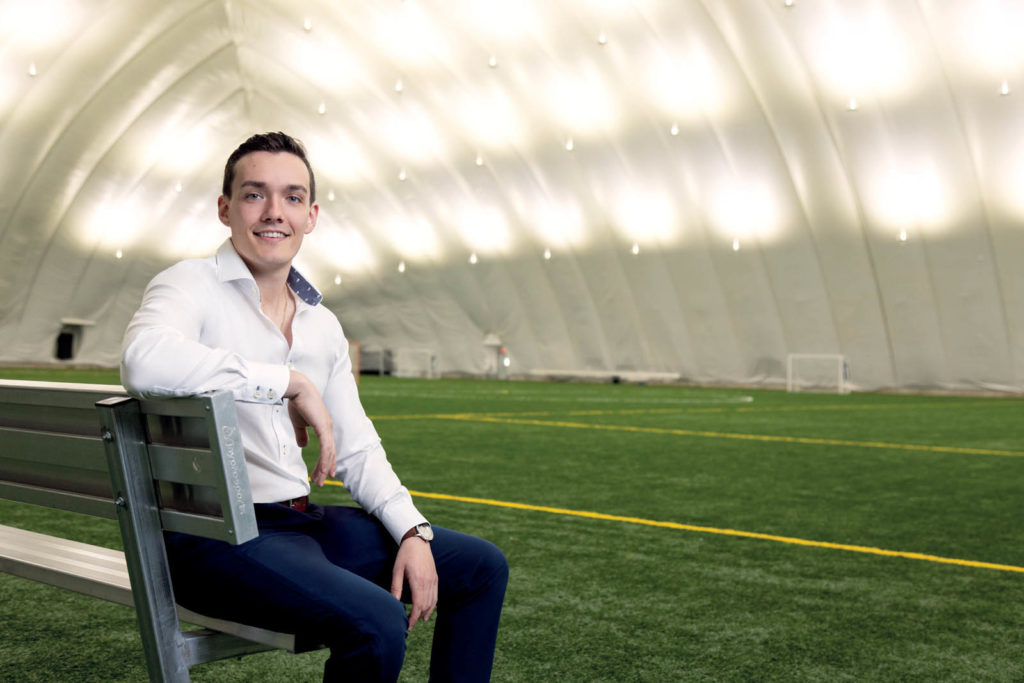
The news headlines were alarming. Just before Christmas 2003, the U.S. Department of Agriculture announced that a case of deadly mad cow disease had been reported in Washington state.
Halfway across the country, animal disease scientists working in Ames, Iowa, faced a double whammy. Not only were they needing to fast-track research related to mad cow disease, but the “bubble” where they were working collapsed during a snowstorm.
“They were panicked when they called us,” says Donato Fraioli, technical sales and product development specialist at Air Structures American Technologies Inc. (ASATI). “Their bubble hadn’t lasted six months. When they asked how fast a replacement could be built, we told them 30 days, not six months like some of the competition.”
ASATI delivered on its promise. Solving big challenges is nothing new for this third-generation, family-owned company based in Rye Brook, N.Y. “That’s what’s so exciting about this business,” Fraioli says. “We love telling clients yes.”
When Fraioli’s grandfather Dan Fraioli established ASATI in the 1960s, he created a whole new category of buildings with his innovative air-supported structures. The Fraioli family continues to advance the latest technology in this niche.
“There’s no school or textbook where you can learn this stuff,” says Donato Fraioli, whose family holds 27 patents related to air-supported structures. “We believe that out of every challenge comes a solution.”
A new class of buildings
For more than 50 years, ASATI has patented, designed, engineered and built more than 5,000 air-supported structures. Just don’t call them “bubbles.”
“Bubbles are inadequately engineered,” Fraioli says. “We’re raising the bar with air-supported structures that function like conventional buildings. They can serve as a replacement for brick-and-mortar structures.”
Dan Fraioli pioneered this new class of buildings. The son of a bread baker, he had a mind for engineering from a young age. He built his first air-supported structure over a tennis court in 1963. “A group of doctors asked him to design and build this dome near what is now Gillette Stadium in Foxborough, Mass.,” Donato Fraioli says. “He took a gigantic leap of faith, but that’s how you grow yourself in life.”
This success launched Dan Fraioli into a new business opportunity. By 1968, his company, ASATI, introduced a cable net system to cover a track-and-field facility at Harvard University. Since then, ASATI has improved upon the original coaxial/low bias cabling system and brought to market the full-bias cable net, which has been applied to hundreds of recreational and commercial air-supported structures.
“The system allows air structures to clear-span several acres,” Donato Fraioli says. “It also gives air structures the ability to withstand heavy winds and snowfall. This allows these domes to meet the similar structural standards as conventional buildings.”
The full-bias cable net completely encapsulates the fabric envelope with an even grid of steel cables. With this system, stress loads are transferred from the fabric to the cable net system, and then down to the foundation.
“If you do it wrong, you can fail big,” Fraioli says. “We marry a flexible fabric with a rigid structural cable system, so it’s critical that the fit isn’t too tight or too loose. For structures over 200 feet wide, the full-bias cable net is the only safe way to build.”
Even in extreme conditions, like 150-mile-per-hour winds or 50 pounds of snow loads, the full-bias cable net reduces fabric loads to about 6 pounds per square inch, he says. In an unharnessed structure, these same conditions could cause loads in excess of 100 pounds per square inch, which can allow tear propagation, reduce the structure’s useful life and create safety issues.
“We’re not the cheapest, but I’ll tell you one thing,” Fraioli says. “You’ll never have to pay twice for one of our structures, because it won’t fail.”
The right fabric is a key to the durability and high quality of ASATI’s products. Dan Fraioli transitioned away from nylon to polyester fabric to extend the life of air-supported structures. “The whole industry followed,” Fraioli says.
As technology advanced and structures lasted longer, ASATI turned to Tedlar® film. This surface is weather resistant, cleanable and inherently flame resistant. Its nonstick nature also reduces dirt accumulation and curtails mildew growth.
“From the fabric to doors to insulation to support structures, we understand what it takes to make air-supported structures work,” Fraioli says. “Decades of experience guide us as we continue to innovate and improve.”

Going global
This focus has helped ASATI expand its business across the U.S. and around the globe. One of the biggest growth areas right now is athletics.
“The demand for youth sports complexes is exploding,” Fraioli says. “Kids want larger, climate-controlled, turfed areas with amenities like ‘Ninja Warrior’-style climbing walls, indoor basketball courts and more.”
These large domes aren’t just stand-alone structures anymore. ASATI’s air-supported structures are becoming part of giant sports complexes, complete with hotels and outdoor athletic fields. “I can affix my domes to a conventional building, so owners can look over the field through glass windows from their offices,” Fraioli says. “The mix of conventional construction and fabric architecture makes the facilities attractive.”
An air-supported structure also costs a fraction of a steel structure. While a traditional 100,000-square-foot building can range from $10 to $30 million, an air-supported structure of this size can start at $2.5 million. These domes are also built to last. “While we have a 20-year warranty, I’m expecting 25 to 30 years out of these structures, based on past performance,” Fraioli says.
Beyond recreation, applications for ASATI’s products include industrial, commercial, environmental and agriculture.
Industrial: ASATI’s structures can be found from gold-mining operations in the mountains of Chile to construction sites where work continues no matter the weather.
Commercial: From temporary airport terminals to entertainment venues to office space, ASATI’s commercial projects meet specific needs, including portability. Structures as large as 30,000 square feet can be rolled into two 8-foot cubic bundles for easy transport.
Environmental protection: The company has built air-supported structures to cover water treatment plants, landfills and coal facilities. An air-supported structure at the International School of Beijing in China incorporates an air-filtration system to keep out 100 percent of air pollution.
Agricultural: ASATI products serve a variety of ag needs, including a 300,000-square-foot shrimp farm near Corpus Christi, Texas. “I think ag offers one of the biggest future opportunities for air domes,” notes Fraioli, referring to the “Grow Dome” project he’s been working on since he was 16. This greenhouse-on-steroids combines all the advantages of an air-supported structure with portability. “In one day, you can have 30,000 square feet for growing high-value crops,” says Fraioli, who is working with Cornell University on this project.
Fraioli credits his family with inspiring him to dream big and take calculated risks. “In a family business, you can’t help but end up talking about air structures when you gather around the dinner table. I’ve learned from the best, since my grandfather is like the Michael Jordan of this industry. We’re always asking how can we innovate, improve and grow.”
Fraioli remains focused on sharing his knowledge of air-supported structures while growing the family business. “I’m excited about the future, because we’re at the tip of where the air-structure industry can go. There’s so much opportunity.”
Darcy Maulsby is Iowa’s Storyteller and a fifth-generation Iowa farmer. She helps businesses discover and share their “wow” stories to help inspire their team members and clients to dream bigger, become better versions of themselves, and change the world for the good. Visit her online at www.darcymaulsby.com.
Photography by John O’Boyle Photography
Project Spotlight: Covering the NFL

ASATI has designed, engineered and built practice domes for 14 NFL teams, including the New York Giants, Seattle Seahawks, Chicago Bears, Philadelphia Eagles and the Tennessee Titans.
“Our patented, full-bias cable net system allows these air structures to be built to virtually any size,” says Donato Fraioli, ASATI technical sales and product development specialist.
A well-designed practice dome has to do more than mimic outdoor playing conditions, free of building obstacles. These domes need to stand up to intense weather conditions, from snow to wind. ASATI designed the Miami Dolphins’ 96,000-square-foot training facility, for example, to withstand category 4 hurricane conditions. ASATI engineers air structures that not only meet, but exceed, local building codes. “When it comes to quality, safety and durability, our domes are game changers,” Fraioli says.
Q&A: How do you attract talent to ASATI?
“I tell potential employees, ‘You’re never just a paper pusher here,’” says Donato Fraioli, ASATI technical sales and product development specialist. “You wake up every day with an exciting new challenge.”
Hands-on learning defines ASATI. “I love to head out to the field and help put up domes,” Fraioli says. “When you hear, ‘One, two, three pull,’ it’s exhilarating, especially when you’re finished and get to watch a 100,000-square-foot dome rise.”
You’re only as good as the people you put around you, Fraioli adds. ASATI typically has 25 to 30 employees, depending on the season. “I tell people that if you want to make something of yourself, join our team. If you work hard, you can be the best in the world in this industry.”
 TEXTILES.ORG
TEXTILES.ORG


